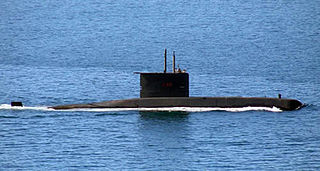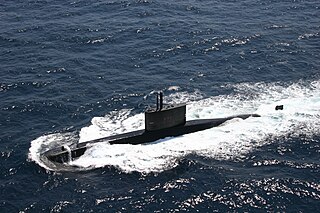The Brazilian Navy is the naval service branch of the Brazilian Armed Forces, responsible for conducting naval operations.

Guanabara Bay is an oceanic bay located in Southeast Brazil in the state of Rio de Janeiro. On its western shore lie the cities of Rio de Janeiro and Duque de Caxias, and on its eastern shore the cities of Niterói and São Gonçalo. Four other municipalities surround the bay's shores. Guanabara Bay is the second largest bay in area in Brazil, at 412 square kilometres (159 sq mi), with a perimeter of 143 kilometres (89 mi).

USS Hermitage (LSD-34) was a Thomaston-class dock landing ship of the United States Navy. She was named for The Hermitage, President Andrew Jackson's estate just outside Nashville, Tennessee.

NAeSão Paulo was a Clemenceau-class aircraft carrier in service with the Brazilian Navy. São Paulo was first commissioned in 1963 by the French Navy as Foch and was transferred in 2000 to Brazil, where she became the new flagship of the Brazilian Navy. IHS Jane's reported that during her career with the Brazilian Navy, São Paulo suffered from serviceability issues and never managed to operate for more than three months at a time without the need for repairs and maintenance.

The Type 209 is a range of diesel-electric attack submarines developed exclusively for export by Howaldtswerke-Deutsche Werft of Germany. Five class variants, including modifications thereof, have been successfully exported to 15 countries, with 68 submarines being built and commissioned to five different variants between 1971 and 2021. More boats have been built to modified designs.

The Brazilian Naval Aviation is the air component of the Brazilian Navy, currently called Força Aeronaval. Most of its air structure is subordinated to the Naval Air Force Command, the military organization responsible for providing operational air support from Navy vessels, while four squadrons are subordinated to the Naval Districts, responsible for inland and coastal waters. ComForAerNav is headquartered at the Naval Air Base of São Pedro da Aldeia, where all aircraft fleet level maintenance is carried out and where the Aeronaval Instruction and Training Center is located, which forms its staff. Its pilots, all officers with one to three years of prior naval experience, fly its helicopters, airplanes and Remotely Piloted Aircraft as extensions of the ships' weaponry and sensors.

The Combat Divers Group, abbreviated to GRUMEC, is a special operations and Counterterrorism unit of the Brazilian Navy. Their main attributions include tasks such as reconnaissance, sabotage, hostage rescue and the elimination of targets of strategic value in maritime and riverine environments.

S Tikuna (S-34) is a Type 209 submarine of the Brazilian Navy. Built in the Brazilian Navy Yard in Rio de Janeiro (AMRJ), it was launched in March 2005 and incorporated into the Brazilian Navy on July 21, 2006, and then transferred to the Naval Operations Command. It is the fourth Brazilian Navy submarine made in Brazil and the largest ever built in the country. The name of this submarine is a tribute to South American indigenous tribe Tikuna inhabiting the region of the Upper Solimões, in the western part of the State of Amazonas.

The Arsenal de Marinha do Rio de Janeiro (AMRJ) is a military organization of the Brazilian Navy. It is located in Ilha das Cobras, at the Guanabara Bay, in the city of Rio de Janeiro. The Arsenal is the main maintenance center and naval base of the Brazilian Navy, involving the design, construction and maintenance of ships and submarines, not only for the Brazilian Navy, but also friendly nations.

MS Wildrake/Holger Dane/NSS Felinto Perry (K-11) was a motor diving vessel originally built and used by Norwegian Company. She was renamed Holger Dane after being sold to Denmark and finally NSS Felinto Perry (K-11) in the Brazilian Navy as a submarine relief ship from the Brazilian Navy. It was equipped to support diving, fire fighting and rescue of submarines.

The Itaguaí Construções Navais S.A. known as ICN, is a Brazilian state-owned defence company specialized in naval-based platforms and naval nuclear engineering, founded on 21 August 2009. The company employs nearly 2,000 people.

S Tupi(S-30) is the lead boat of the Tupi-class submarine of the Brazilian Navy.

S Timbira(S-32) was the third Tupi-class submarine of the Brazilian Navy.

S Tapajó(S-33) was the fourth boat of the Tupi-class submarine of the Brazilian Navy.

The Foca class, or simply F, was the first naval class of submarines operated by the Brazilian Navy. It consisted of the F1, F3 and F5 submarines designed by Italian naval engineer Cesare Laurenti and built in La Spezia, Italy. The name Foca comes from the Portuguese vessel of the class. The class was part of Brazil's 1906 naval program to acquire warships to modernize its navy. The submarines were acquired to serve as a training and maintenance platform for the crews, with few naval actions during the 19 years they were active. The navy incorporated the class on 17 July 1914 and, as a result, expanded its naval structure to house these new vessels, such as the creation of the first naval school for submariners and the incorporation of ships designed to support submarines only.

Tymbira was a torpedo cruiser operated by the Brazilian Navy, belonging to the Tupi-class along with Tamoio and Tupi. During the First World War it patrolled the Brazilian coast. It was dismissed from service on 30 November 1917.

The Submarine Development Program (PROSUB) is a partnership signed between Brazil and France in 2008, with the objective of transferring technology for the manufacture of military vessels. It is a component of the Brazil's Defense Strategy to develop the country's naval power with the production of four conventional submarines and the first Brazilian nuclear-powered submarine. The program will make Brazil one of the few countries to have nuclear technology, alongside the United States, Russia, France, the United Kingdom, China, and India.

Tamoio was a torpedo cruiser operated by the Brazilian Navy, belonging to the Tupi class along with Tupi and Tymbira. The vessel was one of three from the so-called "White Division", on a mission to transport Brazilian president Campos Sales to Argentina in 1900. The ship was decommissioned in 1916.

The Riachuelo class are a Brazilian class of diesel-electric and nuclear-powered attack submarines developed by the state-owned shipyard Itaguaí Construções Navais, based on the French Scorpène class as part of the Submarine Development Program (PROSUB), a naval modernization plan of the Brazilian Armed Forces.



















